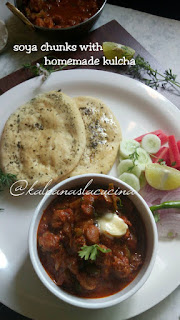Kadhi is the famous Indian dish made from yogurt or buttermilk and gram
flour/ besan. There are so many varieties of this simple dish. People across india
cook this dish in different ways. For example Gujarati Kadhi version, Punjabi
Kadhi, Rajasthani Kadhi, etc. In states of Uttar Pradesh and Punjab kadhi is
also served with fried fritters/ pakora and hence the dish is known as Kadhi
Pakora. Fried pakora make it quite heavy to digest yet delicious in taste.
Gujarati kadhi differs from other and it is sweeter in taste and little thinner
also. It is usually eaten along with plain rice, jeera rice or roti / chapatti.
Here I am sharing a Maharashtrian version of Kadhi which is prepared using sour
buttermilk which give its distinct sour taste. The chickpea flour is mixed with
buttermilk / yogurt to prepare the base for kadhi and served with rice/
khichdi. Maharashtrian version of kadhi is not sweet and tempered with mustard
seeds, cumin seeds and curry leaves. Spice it up by adding green paste with
ginger, garlic and green chillies. Kadhi is considered to be light on stomach
and is ease to digest. While making any kadhi one thing you should keep in mind
is that always mix besan flour in yogurt/ buttermilk and make sure that there
are no lumps in it. Even after pouring the mixture in the tempered spices
continuously stirring is very important till the kadhi gets one boil or else
the curd will get split. When done, serve hot kadhi with steamed rice/ khichdi,
papad and any pickle of your choice and enjoy.
INGREDIENTS:
About 2 Cups Buttermilk
2 tablespoon Ghee
2 tablespoon Besan / Gram Flour
½ teaspoon Turmeric Powder
½ teaspoon Sugar
¼ teaspoon Asafoetida
½ teaspoon Mustard Seeds
½ teaspoon Cumin Seeds
2 teaspoon Green Chilli-Ginger Paste
1 sprig Curry Leaves
Salt as needed
METHOD:
STEP 1 – In a mixing bowl, add buttermilk, turmeric powder and besan flour. Then add salt, sugar and mix well.
Add about 1 cup water and continue to whisk till mixed and no lumps there.
Keep this mixture aside.
STEP 3 – Heat ghee in a pan or wok on medium heat.
STEP 3 – Then add cumin-mustard seeds and asafoetida in it and let them crackle.
STEP 4 – Add green chilli-ginger paste, curry leaves and give a nice stir. Saute for 30 seconds to 1 minute.
STEP 5 – Pour the reserved buttermilk mixture into the kadai. Stir it and cook it.
STEP 6 – Bring it to boil.
STEP 7 – Then allow to simmer for next 5-10 minutes, stirring it in between.
STEP 8 – Cook till it get thickened slightly. [see notes]
STEP 9 – Remove from heat and serve it.
Serve piping hot kadhi with chapatti / roti or rice and enjoy.
NOTES: This kadhi should be not so thin or thick in consistency.
INGREDIENTS:
About 2 Cups Buttermilk
2 tablespoon Ghee
2 tablespoon Besan / Gram Flour
½ teaspoon Turmeric Powder
½ teaspoon Sugar
¼ teaspoon Asafoetida
½ teaspoon Mustard Seeds
½ teaspoon Cumin Seeds
2 teaspoon Green Chilli-Ginger Paste
1 sprig Curry Leaves
Salt as needed
METHOD:
STEP 1 – In a mixing bowl, add buttermilk, turmeric powder and besan flour. Then add salt, sugar and mix well.
Add about 1 cup water and continue to whisk till mixed and no lumps there.
Keep this mixture aside.
STEP 3 – Heat ghee in a pan or wok on medium heat.
STEP 3 – Then add cumin-mustard seeds and asafoetida in it and let them crackle.
STEP 4 – Add green chilli-ginger paste, curry leaves and give a nice stir. Saute for 30 seconds to 1 minute.
STEP 5 – Pour the reserved buttermilk mixture into the kadai. Stir it and cook it.
STEP 6 – Bring it to boil.
STEP 7 – Then allow to simmer for next 5-10 minutes, stirring it in between.
STEP 8 – Cook till it get thickened slightly. [see notes]
STEP 9 – Remove from heat and serve it.
Serve piping hot kadhi with chapatti / roti or rice and enjoy.
NOTES: This kadhi should be not so thin or thick in consistency.









































